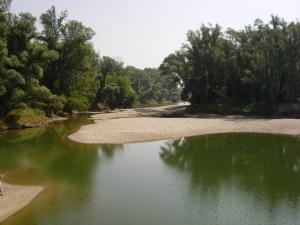Over the past 3 years the AQUACROSS Assessment Framework was developed, tested, and applied in eight case studies across Europe to solve local biodiversity challenges. Finally, results from each Case Study were published in a 30-page Case Study Report and 3-page Executive Summary report. Results from Case Study 3 are summarised below.
Biodiversity challenge: Hydro-morphological alterations, such as disconnection of floodplains, threaten riverine ecosystems and their biodiversity, and are a particular challenge along the Danube. Multiple human activities, including the construction of hydropower plants, expansion of agriculture, and large-scale river regulation measures related to navigation and flood protection are resulting in an ongoing loss of habitat and biodiversity. Our aim: In this Case Study, we apply the AQUACROSS Assessment Framework to identify how management of river-floodplain systems along the Danube can be improved to jointly conserve and restore biodiversity and maximise provisioning of ecosystem services.
Context: Throughout the basin, hydro-morphological restoration of river-floodplain systems is important to conserve biodiversity (in line with EU Biodiversity Strategy to 2020, Target 2 , and the EU Habitats and Birds Directive) and ensure that rivers stretches achieve “good status” according EU Water Framework Directive (WFD). Restoration also support other societal and policy objectives: flood protection, as called for by the EU Flood Risk Directive (FD), pollution reduction to improve the Black Sea marine environment under the EU Marine Strategy Framework Directive, and climate adaptation. However, the complexity and heterogeneity of the environmental problems, lack of data, strong differences in socio-economic conditions, as well as complexity and inconsistencies in legislation along the Danube significantly hampers planning of restoration sites. Only a few countries of the Danube region have already implemented or planned restoration activities, which are due by 2021.
What was done? We conducted a prioritisation of the river-floodplain systems for restoration and conservation, using a novel integrative modelling approach that considered multiple targets related to biodiversity, ecosystem services and socio-economic benefits, in line with Ecosystem-based management. Unlike the current baseline, where each country selects their own restoration sites, our method selected optimal sites across the whole of the Danube.
Results: Our evaluation suggests that the ecosystem-based management approach is more cost-effective than the baseline scenario. Additionally, it represents a traceable and flexible approach that systematically balances the different objectives related to floodplain restoration.
Lessons learned for managing biodiversity: Systematically linking multidisciplinary data and knowledge within one analysis can foster integrated planning across multiple policies, and enable decision-makers to pursue different policy objectives simultaneously. Considering the Danube River at the ecosystem scale, independent from jurisdictional, administrative and political borders (e.g. country scale), supports transboundary coordination and cooperation and therefore has potential to foster consensus on a shared vision for the future.
Applicability: AQUACROSS results can promote successful implementation of river-floodplain restoration. The proposed EBM approach supports the joint selection of restoration sites including prioritisation of protected areas (HBD), and site selection for the next River Basin Management Plans (WFD) or Flood Management Plans (FD).
More info can be found at the Danube case study webpage.


